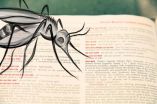(Press-News.org) Researchers at Columbia University and the University of Cologne have created a new model to successfully predict the evolution of the influenza virus from one year to the next. This advance in our understanding of influenza suggests a new, systematic way to select influenza vaccine strains. The findings appear in Nature on Feb. 26.
The flu is one of the major infectious diseases in humans. Seasonal strains of the influenza A virus account for about half a million deaths per year. In a concerted effort, WHO and its Collaborating Centers have closely monitored the evolution of the seasonal H3N2 influenza strains for over 60 years. Based on these data, influenza strains are selected for vaccine production twice per year. Because influenza is a fast-evolving pathogen, the selection of optimal vaccines is a challenging global health issue.
In recent years, it became clear that the evolution of the flu is a complex process. Different influenza strains compete with each other; the race is about how to successfully infect humans. This prompted Marta Łuksza, of Columbia's Biological Sciences department and Michael Lässig of the Institute for Theoretical Physics at the University of Cologne, to ask the question: Can we predict which of these competitors will win the race? "This was a challenge for an evolutionary biologist because there are very few systems in the wild for which quantitative predictions of their evolution are at all feasible," says Łuksza. "It was also a computational and theoretical challenge. While traditional evolutionary thinking is about reconstruction of the past, we had to develop ideas on how to reach into the future." Most importantly, the scientists had to find out which part of the system can be actually predicted and which are random. In their approach they used ideas from physics and computer science.
Łuksza and Lässig used Darwin's principle: survival of the fittest. But what determines how fit an influenza virus is? First, they considered innovation: the virus had to keep a high rate of mutations in order to escape from human immune response. But they also included conservation: these mutations must not compromise the essential functions of a virus, such as the correct folding of its proteins. Through studying the genomes of the virus, they devised a way to predict which viral strains have the optimal combination of innovation and conservation.
While Łuksza and Lässig focused on influenza, their approach highlights a general link between evolution and its consequences for epidemiology that is relevant for many fast-evolving pathogens. In a broader context, it touches upon the fundamental question of how predictable biological evolution is. "There is clearly no general answer to this question," says Łuksza. "But our analysis shows under what auspices limited predictions may be successful." Further extensive tests with global influenza data would help determine whether their method would lead to improved vaccines.
INFORMATION:
A predictive fitness model for influenza
2014-02-26
ELSE PRESS RELEASES FROM THIS DATE:
Sunburns strike twice
2014-02-26
Melanoma is particularly dangerous because it can form metastases in vital organs such as the lungs, liver or brain. UV radiation is considered to be the most significant triggering factor. An interdisciplinary team of researchers from the University Hospital and the LIMES Institute of the University of Bonn has now discovered that sunburns contribute to the development of this malignant disease not only through direct alteration of pigment cell genomes but also indirectly through inflammatory processes in the surrounding tissue. The results are now being published online ...
Major enigma solved in atmospheric chemistry
2014-02-26
According to their results, these extremely low-volatile organic compounds consist of relatively large molecules which contain an almost equal number of carbon, oxygen, and hydrogen atoms. The scientists present a plausible explanation supported by numerous experimental findings of how these vapours are formed almost immediately when plant emissions (e.g. monoterpenes) are released into the air. The vapours can then condense on small aerosol particles (starting from clusters of only a few nanometres in diameter) suspended in the air, causing them to grow to around 100 nanometres ...
Is therapeutic hypothermia beneficial in all patients following cardiac arrest?
2014-02-26
New Rochelle, NY, February 26, 2014–Whole body cooling in comatose patients who have suffered a heart attack can limit the damage to brain tissue caused by the restoration of blood flow and oxygen. But new data indicate that in certain patients therapeutic hypothermia is less effective and may even worsen neurological outcomes, as described in an article in Therapeutic Hypothermia and Temperature Management, a peer-reviewed journal from Mary Ann Liebert, Inc., publishers. The article is available free on the Therapeutic Hypothermia and Temperature Management website at ...
Researchers find virtual computer-based world an effective learning environment
2014-02-26
(Boston)--Boston University School of Medicine (BUSM) researchers have demonstrated the potential of using a virtual computer environment for distance healthcare education for an international audience that often has limited access to conventional teaching and training. In this pilot project led by John Wiecha, MD, corresponding author of the study and associate professor of family medicine at BUSM, a virtual world was created in which participants engaged in a learning activity by creating virtual avatars of themselves to navigate through a three-dimensional computer environment ...
Can a simple handshake predict cancer survival rates?
2014-02-26
Montreal, February 26, 2014 — New acquaintances are often judged by their handshake. Research has now recognized the simple squeeze as an important diagnostic tool in assessing strength and quality of life among critical care patients.
In a study published in the journal, Support Care Cancer, Concordia professor Robert Kilgour and his colleagues at the McGill Nutrition and Performance Laboratory confirmed a link between handgrip strength and survival rates.
The test was simple: 203 patients fighting advanced-stage cancers squeezed a device known as a dynamometer with ...
Ambitious new pollution targets needed to protect Lake Erie from massive 'dead zone'
2014-02-26
ANN ARBOR—Reducing the size of the Lake Erie "dead zone" to acceptable levels will require cutting nutrient pollution nearly in half in coming decades, at a time when climate change is expected to make such reductions more difficult.
That's one of the main conclusions of a comprehensive new study that documents recent trends in Lake Erie's health. It offers science-based guidance to policymakers seeking to reduce the size of toxic algae blooms and oxygen-starved regions called hypoxic zones, or dead zones—two related water-quality problems that have seen a resurgence ...
UNC researchers team up to find new target for dengue virus vaccine
2014-02-26
CHAPEL HILL, NC – Creating a vaccine that protects people from all four types of dengue virus has frustrated scientists for decades. But researchers at the University of North Carolina have discovered a new target for human antibodies that could hold the key to a vaccine for the world's most widespread mosquito-borne disease.
Using an experimental technique new to the dengue field, the labs of Ralph Baric, PhD, and Aravinda de Silva, PhD, showed that a molecular hinge where two regions of a protein connect is where natural human antibodies attach to dengue 3 to disable ...
Research shows ovulation motivates women to outdo other women
2014-02-26
For approximately one week every month, millions of women change their economic behavior and become more focused on their social standing relative to other women. According to new research from The University of Texas at San Antonio (UTSA) and the University of Minnesota's Carlson School of Management, the ovulatory cycle alters women's behavior by subconsciously motivating them to outdo other women. This research could have important implications for marketers, consumers and researchers.
The researchers conducted three studies, one of which had ovulating and nonovulating ...
New advances in the chronic lymphocytic leukaemia genome
2014-02-26
This news release is available in Spanish. A study led by Dr. Roderic Guigó from the Centre for Genomic Regulation in Barcelona, as part of the Chronic Lymphatic Leukaemia Genome Consortium, has made new advances in the study of this disease. The work, which was published (in print version) last week in the journal Genome Research, scrutinised the functional profile of the genes and mutations associated with leukaemia.
The Spanish Chronic Lymphatic Leukaemia Genome Consortium had previously identified the principal mutations involved in the development of the disease. ...
Kessler Foundation researchers study factors affecting self-reporting among people with TBI
2014-02-26
West Orange, NJ. February 26, 2014. Kessler Foundation researchers have found that among individuals with TBI, depression and self-awareness affect subjective reports of memory, quality of life (QOL), and satisfaction with life. The study was published in the February 2014 issue of Brain Injury. (Yael Goverover, Nancy D. Chiaravalloti: The impact of self-awareness and depression on subjective reports of memory, quality- of-life and satisfaction with life following TBI. (doi:10.3109/02699052.2013.860474)
Impairment in self-awareness (the ability to accurately recognize ...




